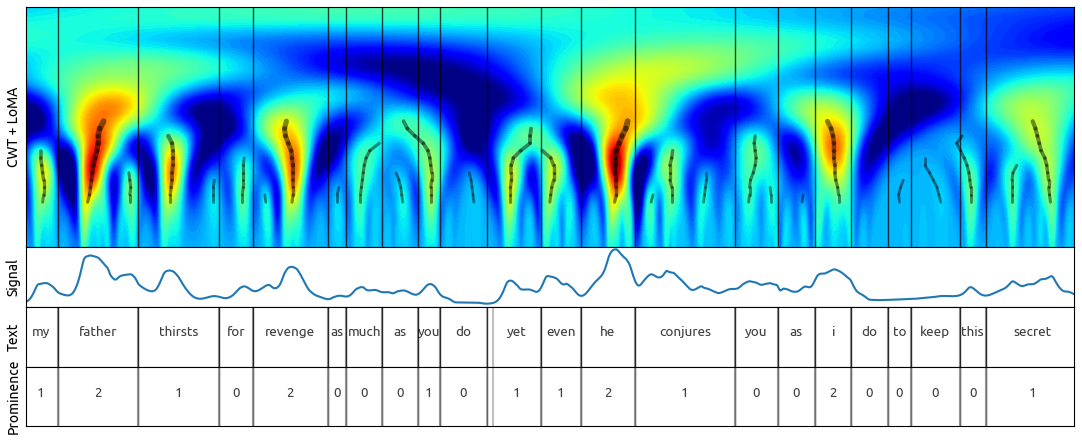Update 30 October 2019:
- Data files modified to include improved word boundary values.
Update 9 September 2019:
- Data files have been modified to include information about the source
file in LibriTTS: Instead of an empty line before each sentence, there is now
a line with
<file> file_name.txt. - The code in
prosody_dataset.pyhas been updated accordingly.
This repository contains the Helsinki Prosody Corpus and the code for the paper:
Aarne Talman, Antti Suni, Hande Celikkanat, Sofoklis Kakouros, Jörg Tiedemann and Martti Vainio. 2019. Predicting Prosodic Prominence from Text with Pre-trained Contextualized Word Representations. Proceedings of NoDaLiDa.
Abstract: In this paper we introduce a new natural language processing dataset and benchmark for predicting prosodic prominence from written text. To our knowledge this will be the largest publicly available dataset with prosodic labels. We describe the dataset construction and the resulting benchmark dataset in detail and train a number of different models ranging from feature-based classifiers to neural network systems for the prediction of discretized prosodic prominence. We show that pre-trained contextualized word representations from BERT outperform the other models even with less than 10% of the training data. Finally we discuss the dataset in light of the results and point to future research and plans for further improving both the dataset and methods of predicting prosodic prominence from text. The dataset and the code for the models are publicly available.
If you find the corpus or the system useful, please cite:
@inproceedings{talman_etal2019prosody,
author = {Aarne Talman and Antti Suni and Hande Celikkanat and Sofoklis Kakouros
and J\"org Tiedemann and Martti Vainio},
title = {Predicting Prosodic Prominence from Text with Pre-trained Contextualized
Word Representations},
booktitle = {Proceedings of NoDaLiDa},
year = {2019}
}
This repository contains the largest annotated dataset of English language with labels for prosodic prominence.
- Download: The corpus is available in the data folder. Clone this repository or download the files separately.
The prosody corpus contains automatically generated, high quality prosodic annotations for the recently published LibriTTS corpus (Zen et al. 2019) using the Continuous Wavelet Transform Annotation method (Suni et al. 2017) and the Wavelet Prosody Analyzer toolkit.
 Image: Continuous Wavelet Transform Annotation method
Image: Continuous Wavelet Transform Annotation method
| Datasets | Speakers | Sentences | Words | Label: 0 | Label: 1 | Label: 2 |
|---|---|---|---|---|---|---|
| train-100 | 247 | 33,041 | 570,592 | 274,184 | 155,849 | 140,559 |
| train-360 | 904 | 116,262 | 2,076,289 | 1,003,454 | 569,769 | 503,066 |
| dev | 40 | 5,726 | 99,200 | 47,535 | 27,454 | 24,211 |
| test | 39 | 4,821 | 90,063 | 43,234 | 24,543 | 22,286 |
| Total: | 1230 | 159,850 | 2,836,144 | 1,368,407 | 777,615 | 690,122 |
The corpus contains data in text files with one word per line and sentences
separated with a line <file> file_name.txt, where the filename refers to the source file in LibriTTS. Each line in a sentence has five items separated with tabs in
the following order:
- word
- discrete prominence label: 0 (non-prominent), 1 (prominent), 2 (highly prominent), (NA for punctuation)
- discrete word boundary label: 0, 1, 2 (NA for punctuation)
- real-valued prominence label (NA for punctuation)
- real-valued word boundary label (NA for punctuation)
Example:
commercial 2 1 1.679 0.715
The dataset can be used for two different prosody prediction tasks: 2-way and 3-way prosody prediction. As the dataset is annotated with three labels, 3-way classification can be done directly with the data. To use the data for 2-way classification task map label 2 to label 1 to get two discrete classes 0 (non-promiment) and 1 (prominent).
This repository contains the code for our BERT and BiLSTM models for predicting prosodic prominence from written English text. To use the system following dependencies need to be installed:
- Python 3
- PyTorch>=1.0
- argparse
- pytorch_transformers
- numpy
To install the requirements run:
pip3 install -r requirements.txtTo download the word embeddings for the LSTM model run:
./download_embeddings.sh
- BERT
- LSTM
- Majority class per word
- See model.py for the complete list
For the BERT model run training by executing:
# Train BERT-Uncased
python3 main.py \
--model BertUncased \
--train_set train_360 \
--batch_size 32 \
--epochs 2 \
--save_path results_bert.txt \
--log_every 50 \
--learning_rate 0.00005 \
--weight_decay 0 \
--gpu 0 \
--fraction_of_train_data 1 \
--optimizer adam \
--seed 1234For the Bidirectional LSTM model run training by executing:
# Train 3-layer BiLSTM
python3 main.py \
--model BiLSTM \
--train_set train_360 \
--layers 3 \
--hidden_dim 600 \
--batch_size 64 \
--epochs 5 \
--save_path results_bilstm.txt \
--log_every 50 \
--learning_rate 0.001 \
--weight_decay 0 \
--gpu 0 \
--fraction_of_train_data 1 \
--optimizer adam \
--seed 1234Output of the system is a text file with the following structure:
<word> tab <label> tab <prediction>
Example output:
And 0 0
those 2 2
who 0 0
meet 1 2
in 0 0
the 0 0
great 1 1
hall 1 1
with 0 0
the 0 0
white 2 1
Atlas 2 2
? NA NA
Main experimental results from the paper using the train-360 dataset.
| Model | Test accuracy (2-way) | Test accuracy (3-way) |
|---|---|---|
| BERT-base | 83.2% | 68.6% |
| 3-layer BiLSTM | 82.1% | 66.4% |
| CRF (MarMoT) | 81.8% | 66.4% |
| SVM+GloVe (Minitagger) | 80.8% | 65.4% |
| Majority class per word | 80.2% | 62.4% |
| Majority class | 52.0% | 48.0% |
| Random | 49.0% | 39.5% |
Aarne Talman: aarne.talman@helsinki.fi
[1] Heiga Zen, Viet Dang, Rob Clark, Yu Zhang, Ron J Weiss, Ye Jia, Zhifeng Chen and Yonghui Wu. 2019. LibriTTS: A corpus derived from LibriSpeech for text-to-speech. arXiv preprint arXiv:1904.02882.
[2] Antti Suni, Juraj Šimko, Daniel Aalto and Martti Vainio. 2017. Hierarchical representation and estimation of prosody using continuous wavelet transform. Computer Speech & Language. Volume 45. Pages 123-136. ISSN 0885-2308. https://doi.org/10.1016/j.csl.2016.11.001.

